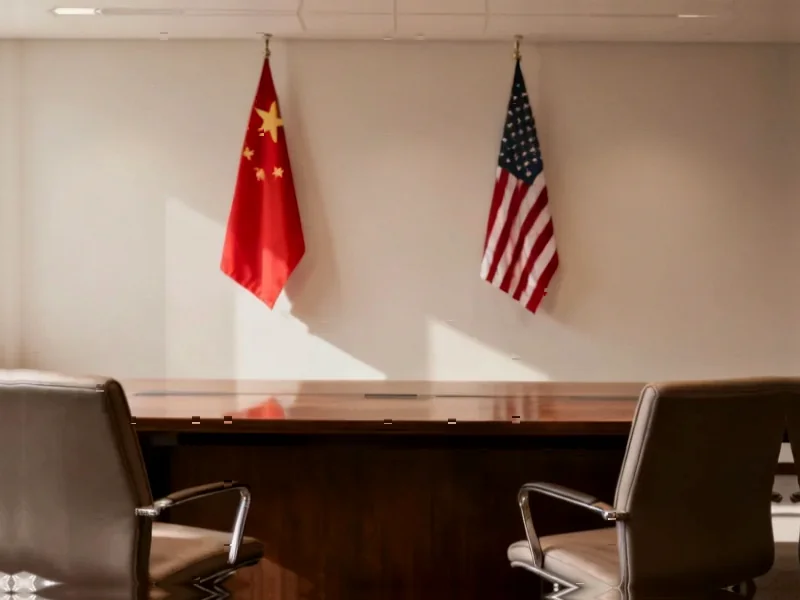According to Fortune, President Trump and President Xi Jinping met for one hour and 40 minutes during Pacific Rim summit gatherings in South Korea, where they agreed to dial back some trade measures and work on resolving others. Trump announced he would reduce his 20% tariff increase on Chinese goods to 10%, bringing average tariffs down from 57% to 47%, while China committed to purchasing 25 million metric tons of U.S. soybeans annually starting with 12 million tons between now and January. The leaders also discussed China purchasing Nvidia computer chips (excluding next-generation Blackwell AI chips), maintaining rare earth exports, and working toward resolving TikTok ownership issues, though China’s response was notably more measured than Trump’s enthusiastic declarations. This temporary truce extends the tariff pause that began in May, but significant questions remain about implementation.
Table of Contents
The Soybean Dependency Reality Check
While Trump’s announcement of 25 million metric tons of annual soybean purchases sounds impressive, this actually represents a return to pre-trade war levels rather than a breakthrough. China imported approximately 32-33 million metric tons of U.S. soybeans annually before the trade conflicts began, meaning this agreement only partially restores previous purchasing patterns. The U.S. agricultural sector’s deep dependency on Chinese markets creates structural vulnerability that temporary purchase agreements cannot resolve. More importantly, China has been actively diversifying its soybean sources to Brazil and other producers during the trade war, developing alternative supply chains that reduce its reliance on American farmers long-term. Trump’s encouragement for farmers to “buy more land and larger tractors” seems premature given that China’s own domestic production has grown to 20 million metric tons while maintaining imports over 105 million metric tons globally.
The Semiconductor Restrictions Dilemma
The Nvidia chip discussion reveals the fundamental contradiction in U.S.-China technology policy. While allowing China to purchase “a lot of the chips” from Nvidia provides temporary relief for the chipmaker and Chinese manufacturers, it doesn’t address the core issue of advanced AI chip restrictions. The exclusion of Nvidia’s next-generation Blackwell AI chips maintains the technological containment strategy while offering commercial concessions. This creates a precarious middle ground that satisfies neither American national security concerns nor China’s ambition for technological parity. More importantly, it fails to resolve the underlying tension between commerce and security that has defined the semiconductor trade relationship.
Rare Earths: Temporary Relief vs. Strategic Leverage
The one-year pause on China’s rare earth export restrictions provides breathing room but doesn’t resolve the fundamental supply chain vulnerability. China controls approximately 60% of global rare earth production and 85% of processing capacity, giving it substantial leverage in any prolonged trade conflict. While Trump characterized the agreement as removing a “roadblock,” it merely postpones rather than resolves the issue. The temporary nature of this arrangement means American manufacturers of electric vehicles, defense systems, and consumer electronics still face uncertainty about long-term access to these critical minerals. This highlights the broader pattern in these negotiations: addressing immediate political pressures rather than building sustainable supply chain resilience.
TikTok Ownership: The Unresolved Digital Sovereignty Battle
The vague commitment to “work with the U.S. to properly resolve issues related to TikTok” suggests both sides are kicking the can down the road on one of the most politically charged technology issues. The fundamental conflict between American national security concerns and China’s digital sovereignty principles remains unresolved. TikTok’s ownership structure represents a microcosm of larger technology governance conflicts that extend far beyond this single application. Without concrete details about potential ownership changes or data governance frameworks, this agreement provides political cover rather than substantive resolution.
Why Structural Tensions Persist
The differing characterizations from both leaders reveal the fundamental gap in expectations. Trump’s triumphant “amazing meeting” rhetoric contrasts sharply with Xi’s call for “positive interactions” and warning against “vicious cycle of mutual retaliation.” This disconnect suggests that while both sides benefit from temporary de-escalation, their underlying strategic objectives remain fundamentally misaligned. The agreement addresses symptoms rather than causes, providing temporary tariff relief without resolving the industrial policy, technology transfer, and market access issues that sparked the trade war. The extension of the truce that began in May indicates both sides recognize the economic costs of escalation, but the absence of a comprehensive framework suggests these stopgap measures will continue characterizing the relationship.
The Implementation Challenge Ahead
History suggests that announced purchase agreements often face implementation hurdles. The 25 million metric tons of soybean purchases depend on market conditions, pricing, and logistical coordination that can disrupt even the most well-intentioned agreements. Similarly, the chip purchases face regulatory scrutiny and potential congressional opposition. The temporary nature of many provisions—including the one-year rare earth export pause—creates built-in expiration dates that could trigger renewed tensions. Without established working groups and clear implementation timelines, these announcements risk becoming political theater rather than substantive policy achievements.
Related Articles You May Find Interesting
- Siemens Energy Bets on T-Mobile’s 5G Network Slicing for Critical Infrastructure
- Canva’s Free Affinity App Challenges Adobe’s Creative Dominance
- Monzo’s Global Gambit: Banking Veteran Takes Helm for Expansion
- Tesla Cybertruck’s Troubled First Year: 10 Recalls and Counting
- Manufacturing’s Service Revolution Faces AI Scaling Crisis



